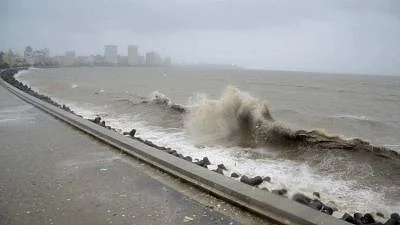Several Indian cities that lie near the sea may get submerged in the next 28 years due to the rise in water level, an analysis has revealed.
Critical properties and road networks in Mumbai, Kochi, Mangalore, Chennai, Visakhapatnam, and Thiruvananthapuram will be submerged by 2050, said the analysis by RMSI, a global risk management firm, as per a report in Hindustan Times.
RMSI’s experts created a high-resolution Digital Terrain Model (topography) for the coastline of the identified cities and used a coastal flood model to map the cities’ inundation levels based on forecasts of rise in sea-level.
In Mumbai, around 998 buildings and 24 km of road length will be affected by potential sea-level rise by 2050, and approximately 2,490 buildings and a road length of 126 km will be affected by potential sea-level rise during high tide.
The report mentioned that Mumbai’s Haji Ali dargah, Jawaharlal Nehru Port Trust, Western Express Highway, Bandra-Worli Sea-link and Queen’s Necklace on Marine drive are at risk of submergence.
In Chennai, a road length of 5 km and 55 buildings are at risk. In Kochi, around 464 buildings are likely to be impacted by 2050 with the number rising to around 1,502 buildings during high tide.
In Thiruvananthapuram, due to sea-level rise by 2050 and sea-level rise with high tide, 349 and 387 buildings, respectively, are likely to be impacted. In Visakhapatnam, around 206 buildings and 9 km of the road network are likely to be inundated.
RMSI Urges for Immediate Intervention
The report also considered findings from the Intergovernmental Panel on Climate Change’s (IPCC) sixth assessment report ‘Climate Change 2021: The Physical Science Basis’ released in August 2021.
‘Assessment of climate change over the Indian region’ a report of the Ministry of Earth Sciences (MoES) also said that sea-level rise in the North Indian Ocean (NIO) occurred at a rate of 1.06–1.75 mm per year during 1874–2004 and has accelerated to 3.3 mm per year in the last two and a half decades (1993–2017).
The amount of greenhouse gases like CO2 emitted by the world needs to peak by 2025 followed by a 43% reduction in the 10 years after to limit global warming to 1.5 degree C by the year 2100, the Intergovernmental Panel on Climate Change (IPCC) said on Monday.
RMSI suggested interventions such as land reclamation, increasing road heights and relocation of buildings or strengthening them against damage.
